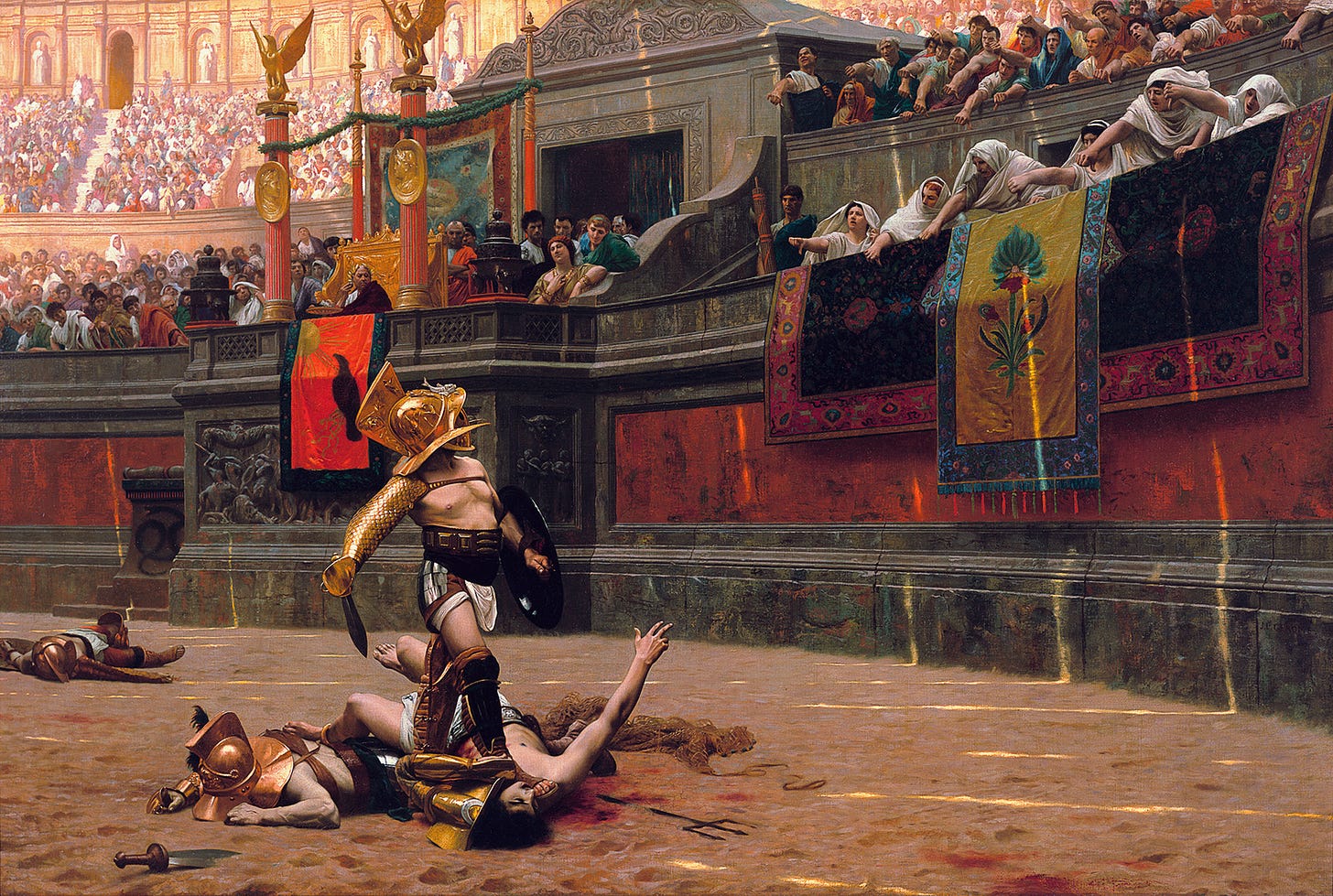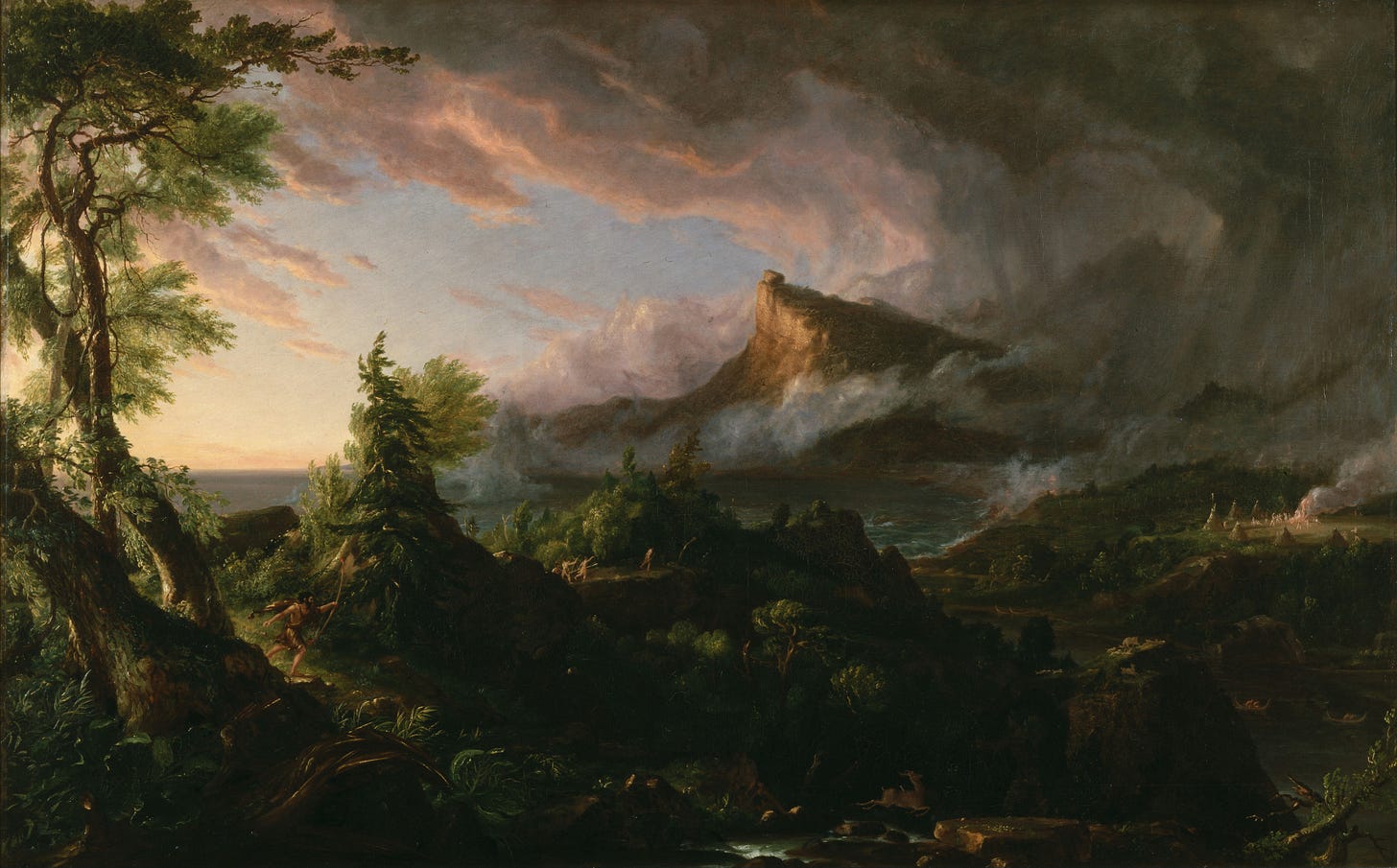“There is the moral of all human tales;
'Tis but the same rehearsal of the past.
First freedom and then Glory – when that fails,
Wealth, vice, corruption – barbarism at last.
And History, with all her volumes vast,
Hath but one page...”
— Canto IV, Childe Harold’s Pilgrimage, Lord Byron (1818)
The Colosseum is so famous it’s almost a cliché. Like Michelangelo’s David or the Mona Lisa, the Colosseum occupies a sacred space in our collective imagination. As a result, it’s almost impossible to reach an age where one can fully appreciate the achievement embodied by the ancient arena without already having seen its picture a thousand times.
One could be forgiven for thinking that it can hold no surprises for the visitor seeing it in its stony flesh for the first time. I know that’s how I felt. How wrong I was. Catching a first glimpse of its arches from a kilometre away set my heart racing. Goosebumps covered my arms. It seems part of me is still the little boy excited by the idea of gladiators battling it out in front of a baying crowd. I wrote in my journal at the time:
The first thing you notice about the Colosseum is its vastness. One is taken aback even despite our modern acclimation to huge structures. Pictures simply do not do it justice — you need a human eye view to truly appreciate its scale. Much of the decoration has been stripped away by centuries of looters, but a few reliefs remain - depicting gods, heroes, and emperors. What stories these walls could tell, of centuries of bloodshed and glory, if they could only speak! Not just of the gladiator duels, animal hunts, and the mock naval battles of the games, but of the millennia of history it has seen since. It’s easy to forget the hulking skeleton has been a ruin far longer than it ever functioned as an arena. At one stage, a Pope even took up residence within its walls.
Two thousand years is too long a time period to wrap one’s head around, so I spent some time thinking instead of all the people throughout history to whom this was also ancient: St Paul; Charlemagne; Michelangelo; Da Vinci; Lord Byron; Mussolini; Audrey Hepburn.
Indeed, everything I wrote and thought about the Colosseum has already been thought countless times before. Just read Goethe, writing in 1786:
“In the evening we came upon the Colosseum, when it was already twilight. When one looks at it, all else seems little; the edifice is so vast, that one cannot hold the image of it in one's soul - in memory we think it smaller, and then return to it again to find it every time greater than before.”
— J. W. Goethe, Italian Journey (1786)
Or John Eustace, writing in 1802:
“Let the spectator first place himself to the north, and contemplate that side which depredation, barbarism, and ages have spared, he will behold with admiration its wonderful extent, well proportioned stories and flying lines, that retire and vanish without break or interruption. Next let him turn to the south, and examine those stupendous arches, which, stripped as they are of their external decorations, still astonish us by their solidity and duration.”
— John Chetwode Eustace, A Classical Tour through Italy (1802)
The centuries and centuries of visitors have shared one other thought too:
How could a civilisation great enough to build monuments such as this ever come to ruin?
This is an interesting question, and perhaps a pertinent one. Historians have posited that if we can learn the lessons of civilisational collapse from history, perhaps we can save our own from the same fate.
“The experiences of the human race have been recorded…for some four thousand years. If we attempt to study such a period of time in as many civilisations as possible, we seem to discover the same patterns constantly repeated under widely differing conditions of climate, culture and religion…The life-expectation of a great civilisation, it appears, commences with a violent, and usually unforeseen, outburst of energy, and ends in a lowering of moral standards, cynicism, pessimism and frivolity.”
— Sir John Bagot Glubb1, The Fate of Empires and Search for Survival (1976)
Thomas Cole, founder of the Hudson River School and master of Romantic landscapes, took the root of this idea and made it into the most spectacular art.2 His The Course of Empire series, created in the years 1833–1836, depicts the rise and fall of a fictional civilisation, from a pastoral state to a glorious empire, and then to a decadent and ruined aftermath.
In this post, we’ll take a look at the paintings one by one and map them onto the history of Rome. For total cultural immersion, I’ve accompanied each artwork with a poem and a piece of music.3
The Savage State
This painting shows the dawn of civilisation (literally, dawn is breaking and night is in retreat). In a very Rousseauian scene, the people live in harmony with nature. The landscape is wild and rugged, with mountains, forests, waterfalls, and a stormy sky. A group of hunters chase a deer across a river, while others gather around a fire or dwell in tents. The painting evokes a sense of freedom and adventure, but also hints at the potential for violence and conflict.
We can imagine this was the state of existence in the area we now call Rome from when modern humans first spread across Europe, about 40,000 years ago, up until the Neolithic Revolution.
“I wandered lonely as a cloud That floats on high o'er vales and hills, When all at once I saw a crowd, A host, of golden daffodils; Beside the lake, beneath the trees, Fluttering and dancing in the breeze.” — William Wordsworth, first stanza of I Wandered Lonely as a Cloud (1807)








